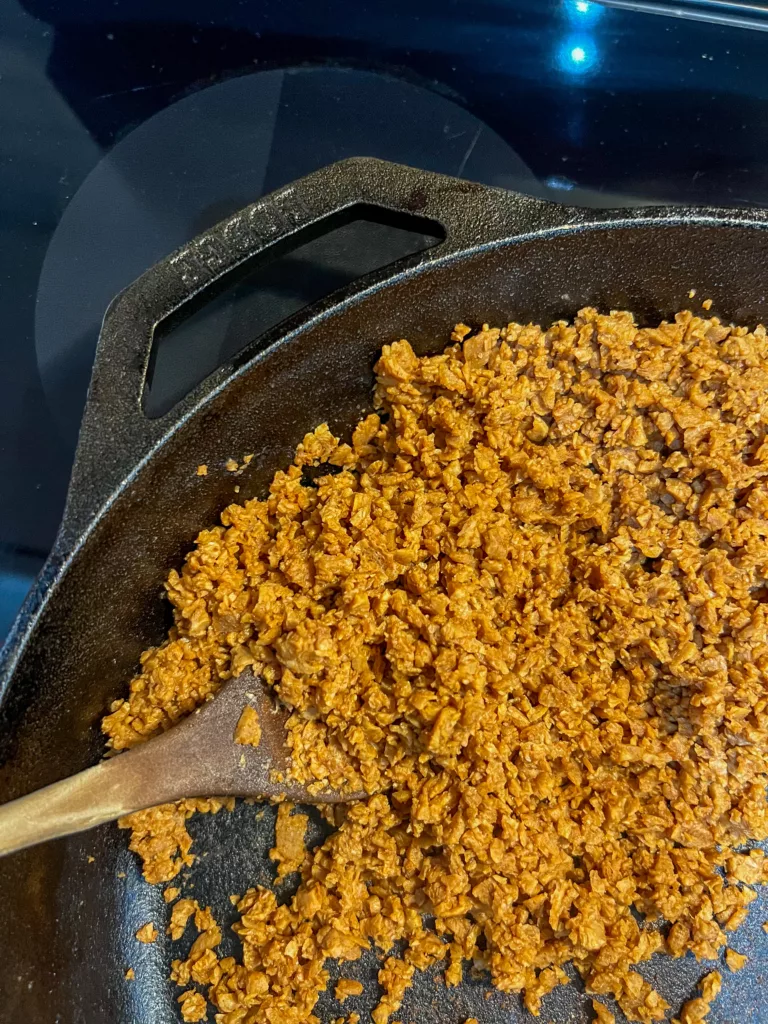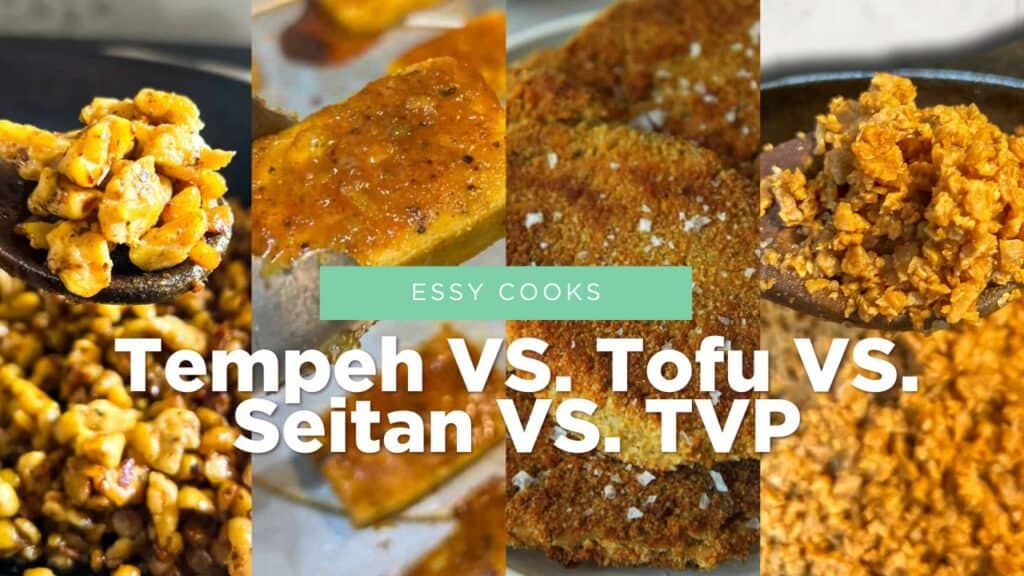Welcome to our comparison chart on the nutritional benefits of four popular plant-based protein sources: Tofu, Tempeh, Seitan, and Textured Vegetable Protein (TVP). These versatile ingredients are staples in many vegan and vegetarian diets, and each has its own unique nutritional profile.
What Are Tofu, Tempeh, Seitan, and TVP?
Tofu: Made from soybeans, Tofu is a versatile, protein-rich food with a mild flavor. Often referred to as bean curd, it can be found in different textures such as silken, firm, and extra-firm. Tofu’s adaptability makes it a popular ingredient in various dishes, from stir-fries to smoothies.
Tempeh: Tempeh is also made from soybeans but undergoes a fermentation process that gives it a firm texture and nutty flavor. This protein-packed food is a staple in Indonesian cuisine. It is known for its gut health benefits due to the probiotics produced during fermentation.
Seitan: Known as wheat meat, Seitan is made from vital wheat gluten. It has a chewy, meaty texture, making it an excellent substitute for meat in various dishes. Seitan is rich in protein but lacks some essential amino acids. So it’s important to pair it with other protein sources.
TVP (Textured Vegetable Protein): TVP is made from defatted soy flour and is often used as a meat substitute in dishes like chili, tacos, and spaghetti sauce. It has a neutral taste, allowing it to absorb the flavors of the dishes it’s cooked in.
Plant-based Protein Nutritional Benefits Comparison Chart: Tofu Vs. Tempeh Vs. Seitan Vs. TVP (Textured Vegetable Protein)
In this chart, we will compare the nutritional benefits of each protein source to help you make an informed decision about which one to include in your diet. Whether you’re looking to boost your protein intake, increase your iron levels or increase your fiber intake, this chart will help you to find the best option for you.
| Nutritional Info (per 100 grams) | Tofu | Tempeh | Seitan | TVP |
|---|---|---|---|---|
| Protein (g) | 10 | 19 | 25 | 12 |
| Fat (g) | 5 | 8 | 1 | 1 |
| Carbohydrates (g) | 2 | 9 | 6 | 8 |
| Fiber (g) | 1 | 3 | 0 | 4 |
| Iron (mg) | 1.9 | 2.8 | 2.5 | 2.1 |
| Calcium (mg) | 434 | 176 | 0 | 0 |
As you can see from the chart. Tofu is an excellent source of protein and iron. While Tempeh is high in both protein and fiber. Seitan is an excellent source of protein and is low in fat and calories. While TVP is a good source of protein and iron.
Tasting the Differences: A Comparison of Tofu, Tempeh, Seitan, and TVP’s Texture and Flavor
When it comes to plant-based proteins, the taste and texture can vary greatly between Tofu, Tempeh, Seitan, and TVP.
Tofu, Tempeh, Seitan, TVP, Plant-Based Protein Texture and Flavor Comparison Chart
| Protein | Texture | Flavor |
|---|---|---|
| Tofu | Silken, firm, or extra-firm | Mild, adaptable to various flavors |
| Tempeh | Firm, nutty | Nutty, slightly earthy |
| Seitan | Chewy, meat-like | Savory, can be flavored to taste like meat |
| TVP | Dried, must be rehydrated | Mild, adaptable to various flavors |
Soybeans make Tofu, also known as bean curd, which has a subtle flavor. Its versatility allows it to take on the taste of any marinade or seasoning. Its texture can range from silken to extra-firm, and sautéing, frying, or blending it into smoothies are the best ways to enjoy it
Tempeh, on the other hand, is made from fermented soybeans and has a nutty and earthy flavor. Its texture is firm and chewy. Making it great for grilling, marinating, or crumbling into salads. Seitan, also known as wheat gluten. It has a chewy texture and a slightly sweet flavor, making it a great meat alternative in dishes such as stir-fries and stews.
TVP, or textured vegetable protein, derives from soy flour and possesses a neutral flavor, making it an excellent ingredient for absorbing flavors in soups, stews, and chilies.
When it comes to enjoying the taste of these plant-based proteins, it’s all about experimenting with different marinades, seasonings, and cooking methods. Marinate and grill Tofu for a smoky flavor. Crumble and sauté Tempeh with your favorite spices. Pair Seitan with savory sauces and add it to stir-fries, and rehydrate. TVP is to be used as a meat substitute in chili and tacos. Ultimately, the key is to find the right combination of flavors and textures that suit your taste buds.
Tofu Tempeh Seitan TVP Plant-Based Protein Nutritional Benefits
When it comes to plant-based protein options, it can be overwhelming to navigate the aisles of your local health food store. Tofu, tempeh, seitan, and TVP are all popular choices, but what sets them apart from one another? In this ultimate guide, we’ll dive into the nutritional benefits and unique characteristics of these four plant-based protein options, and help you make a more informed decision on which one to add to your next recipe.
Tofu: The Versatile Protein Powerhouse
Tofu is often the first thing that comes to mind when thinking about plant-based protein. It’s a staple in Asian cuisine and has become increasingly popular in recent years as a versatile ingredient in a variety of dishes. Tofu is really my go-to source of protein and it’s in so many of my favorite recipes!
The reason it’s one of my favorite vegan protein sources is that it’s so incredibly versatile and can cut or torn into different shapes to create a different result. You can make anything from crispy tofu nuggets, to silky smooth high-protein chocolate mousse! The good news is that if you don’t love the taste of tofu, you taste buds can actually adapt fairly quickly. So if you are looking to eat less meat, or just eat more tofu try incorporating it for a few weeks, and be sure to try out recipes that are full of your favorite sauces and seasonings!
Nutritional Value: In addition to protein, tofu is rich in calcium (thanks to the addition of calcium sulfate during the tofu-making process), low in saturated fat, and a good source of b vitamins. This makes it a nutritious option for those seeking plant-based protein sources.
Protein Content: A 100-gram serving of tofu contains about 10 grams of protein. While this might seem like less protein compared to some other options, tofu is still a great source of protein, especially when paired with other vegetarian proteins to create a complete protein profile.
Serving Size: A typical serving size of tofu is about 3.5 ounces (100 grams), which can be easily incorporated into stir-fries, soups, and even the whole culinary world of tofu burgers.
Tempeh: The Fermented Protein with a Nutty Flavor
Tempeh offers a different texture and flavor compared to tofu, and it’s a great way to boost your protein intake. Once again, the flavor may not be for everyone but your taste buds do adapt over time. If you find the taste or smell a little funky (it is a fermented food after all) try steaming it for a few minutes before frying it. This will help reduce any unpleasant flavor.
Nutritional Value: Beyond protein, tempeh is also high in fiber, essential amino acids, and b vitamins, making it a valuable addition to a variety of dishes. The fermentation process used to make tempeh also contributes to gut health, adding another layer of nutritional benefit.
Protein Content: A 100-gram serving of tempeh packs around 19 grams of protein. This makes it a popular meat substitute in many vegetarian diets, providing much protein in a compact, nutrient-dense form.
Serving Size: A standard serving of tempeh is also around 3.5 ounces (100 grams). Its firm texture and umami flavor make it ideal for grilling, sautéing, or crumbling into dishes.

We have a great Tempeh Breakfast Sausage Crumble Recipe here!
Seitan: The High-Protein, Wheat-Based Meat Alternative
Seitan, also known as wheat protein or wheat meat, is a chewy meat-like product made from gluten, the protein found in wheat. It’s become increasingly popular in recent years as a plant-based meat alternative. A lot of the fake meats or mock meats you buy in the store do include some form of vital wheat gluten in the recipe. However, making your own seitan is healthier and more cost effective. The cooking process can be a bit of work, but the high-protein content and delicious flavor make it worth while!
Nutritional Value: While seitan is a great source of protein, it’s important to note that it lacks some essential nutrients found in other plant-based proteins. However, when paired with whole grains and other plant-based sources of protein, it can contribute to a balanced diet.
Protein Content: Seitan is the highest in protein among these options, with about 25 grams of protein per 100 grams. This makes it an excellent choice for those looking to increase their protein intake, especially in a vegetarian diet.
Serving Size: Like tofu and tempeh, a typical serving size of seitan is about 3.5 ounces (100 grams). It’s a versatile ingredient that can be used to make mock chicken, mock duck, and other vegetarian proteins that mimic the texture of meat.
TVP (Textured Vegetable Protein) :The Affordable, Protein-Rich Soy Product
Textured Vegetable Protein (TVP) is an affordable and easy way to add protein to your diet, particularly for those looking to reduce their meat consumption. The thing I love the most about TVP is how easy it is to prepare! It works in basically any recipe where you want to replace ground beef by adding a few sauces and seasonings and hot water to rehydrate the TVP. This is typically available in the health isle of the grocery store, in health food stores, or even at the bulk store.
Nutritional Value: TVP is made from defatted soy flour, which is a byproduct of soybean oil production. It’s low in fat and calories and has a neutral taste, allowing it to absorb the flavors of the dishes it’s added to. This makes it a versatile option in the food industry for creating plant-based meat alternatives.
Protein Content: TVP contains about 12 grams of protein per 100 grams, making it a good source of protein, especially when used as a substitute for ground meat in dishes like chili, tacos, and spaghetti sauce.
Serving Size: TVP is typically rehydrated before use, and a serving size after rehydration is about 1/2 cup, which provides a substantial amount of protein while remaining low in fat and calories.

We have a great Vegan Ground Beef Substitute Recipe With TVP here.
So, which one is the best choice for you? It ultimately depends on your dietary needs and preferences. Tofu and tempeh are both great sources of protein, iron, and calcium, while seitan is a good source of protein, but not as nutrient-dense. TVP
Health Benefits of Plant-Based Proteins
Switching to plant-based proteins like Tofu, Tempeh, Seitan, and TVP has numerous health benefits. A diet rich in plant-based proteins can help reduce the risk of heart disease, aid in weight management, and provide all the essential amino acids your body needs.
Soy Protein: Tofu, Tempeh, and TVP are all soy-based products, making them excellent sources of soy protein. Soy protein has been shown to lower cholesterol levels, reduce the risk of heart disease, and support overall health.
Gut Health: The fermentation process used to make Tempeh not only enhances its flavor but also introduces beneficial probiotics that support gut health.
Weight Management: High protein content in these plant-based options can help you feel fuller longer, making them great for weight management.
Taste and Texture: A Sensory Guide
Each of these plant-based proteins has a unique texture and flavor, which can significantly impact how they’re used in cooking.
- Tofu: Tofu has a mild flavor and can take on the taste of any marinade or seasoning. Its texture ranges from silken (great for desserts) to extra-firm (ideal for grilling).
- Tempeh: Tempeh has a firm texture and a nutty, slightly earthy flavor. It holds up well in grilling and frying, making it a great addition to sandwiches and salads.
- Seitan: Seitan has a chewy, meaty texture that’s perfect for mimicking the texture of meat in various dishes. It can be flavored to taste like chicken, beef, or even duck (mock duck).
- TVP: TVP is sold dried and needs to be rehydrated before use. Once rehydrated, it has a chewy texture and neutral taste, making it a versatile ingredient in dishes like chili, tacos, and veggie burgers.
Cooking with Tofu
Cooking with Tofu is straightforward, but there are a few tips to get the best results:
- Press the Tofu: Remove excess water by pressing Tofu with a tofu press or by placing it between paper towels and a heavy object. This helps the Tofu absorb more flavors during cooking.
- Marinate: Tofu’s neutral taste makes it perfect for marinating. Use soy sauce, soy milk, or other flavorful liquids to infuse Tofu with taste.
- Cooking Methods: Tofu can be grilled, sautéed, fried, or blended into smoothies. Extra-firm Tofu works well in stir-fries, while silken Tofu is ideal for creamy desserts.
View Plant Based Tofu Recipes Here
Cooking with Tempeh
Tempeh’s firm texture and nutty flavor make it a favorite among plant-based protein sources.
- Marinate: Like Tofu, Tempeh benefits from marination. Try marinating Tempeh in soy sauce, black beans, and other flavorful ingredients.
- Popular Dishes: Tempeh can be crumbled into salads, grilled as a burger patty, or sautéed with vegetables. It’s also great in stir-fries and as a sandwich filling.
View Plant Based Tempeh Recipes Here
Cooking with Seitan
Seitan, with its meaty texture, is an excellent substitute for animal proteins in various dishes.
- Making Seitan: Seitan is made from vital wheat gluten. Mix wheat flour with water to form a dough, then rinse away the starch to leave the protein-rich gluten behind.
- Flavoring: Seitan can be flavored with soy sauce, herbs, and spices to mimic the taste of chicken, beef, or other meats.
- Cooking Methods: Seitan can be grilled, sautéed, baked, or simmered in soups and stews. Its chewy texture makes it ideal for dishes like stir-fries and stews.
Cooking with TVP
TVP is a versatile, easy-to-use plant-based protein that works well in various dishes.
- Rehydrating TVP: To prepare TVP, simply soak it in hot water or broth until it rehydrates. This process takes about 10 minutes. To make the TVP into ground beef add some spices, seasonings, and cook for a few minutes in hot oil on a cast iron skillet for the best results.
- Incorporating into Dishes: TVP is commonly used in dishes like chili, tacos, and spaghetti sauce. It absorbs the flavors of the dish, making it a versatile ingredient.
View Plant Based TVP Recipes Here
Environmental Impact
Switching to plant-based proteins like Tofu, Tempeh, Seitan, and TVP is not only good for your health but also for the environment.
- Sustainability: Plant-based proteins have a lower environmental impact than animal proteins. They require less land, water, and energy to produce and generate fewer greenhouse gases.
- Comparison to Animal Proteins: Producing plant-based proteins like Tofu and TVP generates significantly fewer greenhouse gas emissions than producing beef or pork.
Who Should Choose What?
When choosing between Tofu, Tempeh, Seitan, and TVP, consider your dietary needs and preferences.
- Gluten-Free Diets: If you have celiac disease or a gluten sensitivity, avoid Seitan, as it’s made from wheat gluten. Tofu, Tempeh, and TVP are gluten-free options.
- Soy Allergies: If you’re allergic to soy, avoid Tofu, Tempeh, and TVP. Seitan is a soy-free alternative.
- High-Protein Needs: If you’re looking to increase your protein intake, Seitan offers the highest protein content, but be sure to pair it with other proteins to get all essential amino acids.
Common Myths About Plant-Based Proteins
There are many myths surrounding plant-based proteins, but it’s important to separate fact from fiction.
- Soy Myths: Some people worry that soy products like Tofu and Tempeh can affect hormone levels, but studies have shown that moderate consumption of soy does not negatively impact hormone balance.
- Protein Quality: There’s a misconception that plant-based proteins are inferior to animal proteins. While it’s true that some plant proteins are incomplete, you can easily meet your protein needs by eating a variety of plant-based foods.
- Taste and Texture: Some people believe that plant-based proteins are bland or have an unpleasant texture, but when cooked properly, Tofu, Tempeh, Seitan, and TVP can be delicious and satisfying.
Conclusion: Tempeh, Tofu, Seitan, and TVP Comparison
Tofu, Tempeh, Seitan, and TVP are all excellent sources of plant-based protein, each with unique flavors, textures, and nutritional benefits. Whether you’re new to plant-based eating or a seasoned pro, incorporating these protein-rich foods into your diet can offer numerous health benefits while supporting environmental sustainability. Explore these options, experiment with recipes, and enjoy the delicious, nutritious world of plant-based proteins!
Sources For Tofu Tempeh Seitan TVP Plant-based protein Nutritional Benefits Comparison
- The Tofu and Tempeh Nutrition Center: https://www.tofu-tempeh.com/nutritional-information/
- The Vegetarian Resource Group: https://www.vrg.org/nutrition/
- The Spruce Eats: https://www.thespruceeats.com/
- The United States Department of Agriculture (USDA): https://www.nal.usda.gov/
- The World’s Healthiest Foods: http://www.whfoods.com/






















This was great!! I didn’t really see how much protein Seitan has I’m going to try and incorporate that into my meals more often.
Thanks for the feedback Leslie and cooking with seitan is a great way to incorporate more plant based protein into your diet.
Very informative thank you. I’m just starting to eat more plant based I’m up to 3 nights a week the goal is 5 by the end of the year and then fully or as much as possible in 2025! Your site has been super helpful and love your recipes at least the ones I have made so far.
Thank you SOO much for your review! I’m so happy you are finding it informative and love your goals! Thank you so much for trying out the recipes. I’m so happy to hear they’ve been helpful as you eat more plant based! Please let me know if you have any questions or any recipes you’d like to see!